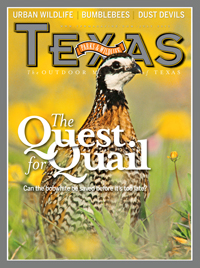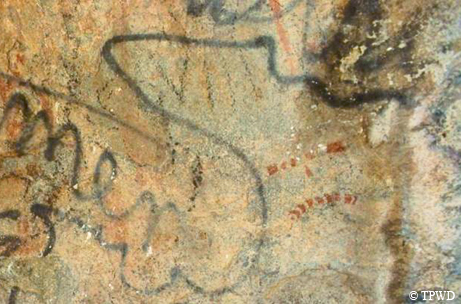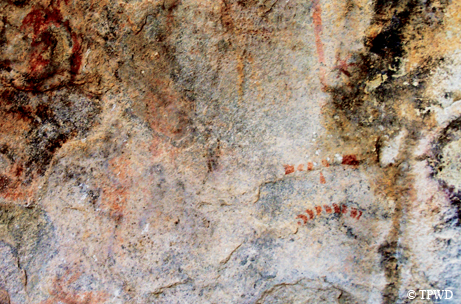
Goodbye, Graffiti
Breakthrough laser techniques remove vandalism from pictographs at Hueco Tanks.
By Russell Roe
The rock paintings at Hueco Tanks State Park and Historic Site represent a pictorial history book with chapters that go back to prehistoric times. Unfortunately, modern vandals have scribbled on several of the pages.
In a program to restore some of the park’s pictographs, conservators are using cutting-edge techniques to remove graffiti from on top of the pictographs without harming the images themselves, restoring them as much as possible to the way the original artists intended.
The techniques, using advanced lasers and noninvasive pigment sampling, represent a breakthrough in rock art conservation, says Wanda Olszewski, superintendent at Hueco Tanks.
Hueco Tanks, about 30 miles east of El Paso, is one of the most important pictograph sites in the Southwest. It has 275 known pictograph panels with 3,000 to 6,000 individual figures and the largest collection of painted faces, or masks, in North America.
The oldest figures date back several thousand years, but most of the rock paintings were done 1,800 to 550 years ago by the Jornada Mogollon culture. Since that time, tribes such as the Mescalero Apaches have also left behind paintings on the rocks.
From the 1960s to 1990s, vandals left their mark on the park, spraying graffiti on the rocks and in some cases on top of irreplaceable pictographs.
“One particular site I looked at early in my career here has a little Jornada Mogollon-era painted mask that was frowning,” Olszewski says. “It has this brow created out of a natural bump in the rock. It has eyes painted on it, and it’s got this frowning face. All around it, somebody back in the ’60s or ’70s painted ‘Thunderbird’ in spray paint on top of it. It was horrible. I remember thinking: Boy, it’s like this mask knew what was coming. That was one that has always affected me quite a bit. There are others, too, that we thought there was just no way to ever get back.”
Conservators have worked over the years to remove graffiti at the park using conventional methods such as solvents and abrasives, but those techniques have limitations and couldn’t be used where graffiti covered rock art.
With changes in conservation technology, park officials began to consider the possibility of laser removal of graffiti. Chicago-based Conservation of Sculpture and Objects Studio Inc., which specializes in laser restoration of buildings, sculptures and other artworks, got the contract to tackle the Hueco work.

A Hueco Tanks pictograph before (above) and after (below) laser removal of graffiti.

In the pilot phase of the project, in 2009, the conservators used lasers to successfully remove graffiti that was not on top of pictographs.
“That was an important first step in a carefully planned, multi-phase project to ultimately remove graffiti from rock art,” says Tim Roberts, TPWD cultural resource coordinator.
Next, the conservators worked to calibrate their lasers to distinguish between graffiti and rock art. They wanted to analyze the chemical composition of the pigments and re-create in their studio the graffiti-on-pictograph conditions found at Hueco. They took physical samples of the graffiti but had to use noninvasive techniques to sample the pictographs.
Park officials wouldn’t let them touch the rock art, and that presented an interesting challenge.
“Imagine that you’re asked to clean something that you’re not allowed to touch,” says conservator Andrzej Dajnowski. “That was our scenario. Before you start cleaning something that valuable, you want to know what that thing is. But we couldn’t touch it, couldn’t take a sample. So all the techniques used were experimental and new.”
With help from the Philadelphia Museum of Art and Bruker Optics, Dajnowski and his colleagues used X-ray fluorescence, Raman spectroscopy and infrared spectroscopy to take readings from the pictographs to determine the chemical composition of the pictograph pigments and binders. These techniques have been used on fine art paintings, but it was the first time that this combination of techniques was used in the study of rock art, Roberts says.
Dajnowski and his team went back to the studio to create mockups of rock art and graffiti with pigments identical to what they found at Hueco. They experimented with their lasers to determine the correct settings for removing only the graffiti layer.
When satisfied with the results, they returned to Hueco in the summer of 2011. Before they could proceed, they had to demonstrate to Native American leaders that their techniques wouldn’t harm the rock art. With that permission granted, they headed to their first project, a site near and dear to Olszewski: the frowning man and Thunderbird. Roberts says, “The first site, I’d say, was 100 percent successful in removing the painted graffiti.”
Olszewski pointed out that removing the graffiti by laser is a painstaking process, carried out slowly and meticulously in a harsh desert environment for hours and days at a time, often in cramped conditions. It was a challenging time for the conservators, park staff and the equipment, which required certain conditions to operate effectively.
The second site treated is known as the Puking Horse. Graffiti around the Puking Horse pictograph had been previously treated with conventional methods, but the graffiti directly on the rock art was left alone. Dajnowski found that even with the laser, he couldn’t safely remove all of the graffiti, but he was able to lighten it.
Dajnowski and his team returned in the fall of 2011 to treat a site where a vandal scrawled the word “Castro” about 1 foot high and 8 feet long over some rock art. In September, he’ll come back to work on a site known as HC.
Dajnowski’s contract ran out in mid-2011, and he has been donating his time since then. He says he mostly cares about getting the job done, and done right.
“Money is not the point here,” Dajnowski says. “If I were after money, I would have quit a long time ago. A project like this gives me a lot of professional satisfaction. Nothing like this was done before. It’s a groundbreaking process, a groundbreaking project.”
Olszewski has been pleased with the results.
After the work was completed last summer, Olszewski decided it was time to check on an old friend.
“I went over to the site that has the frowning mask on it, and all that graffiti was just gone,” she says. “It was probably one of the coolest things that has ever happened to me here. It seemed so magical that something like that could happen.”
Thanks!
The following people donated time and expertise to the project:• Andrzej Dajnowski, director, Conservation of Sculpture and Objects Studio Inc. • Bartosz Dajnowski, project manager, Conservation of Sculpture and Objects Studio Inc. • Andrew Lins, conservation department chair, Philadelphia Museum of Art • Beth Price, senior scientist, Philadelphia Museum of Art • Thomas J. Tague, applications manager, Bruker Optics Inc. |
Related stories

